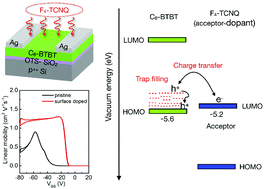Understanding molecular surface doping of large bandgap organic semiconductors and overcoming the contact/access resistance in organic field-effect transistors†
Abstract
The contact resistance (Rc) and the effective carrier mobility (μeff) are considered as the important indicators of the performance of organic field-effect transistors (OFETs). Conventionally, the contact resistance is regarded as the interface effect between the metal electrodes and the organic semiconductors, while the carrier mobility is correlated to the crystallinity and π–π stacking of the organic molecules. In the staggered OFETs, Rc is actually closely correlated to μeff through the channel sheet resistance. Besides, the accuracy of the carrier mobility directly extracted from the non-ideal transfer curves with significant contact effect is always questionable. Herein, a diffusion-lead surface doping approach is employed to improve the contact resistance and mobility issues simultaneously. By suppressing the trap states in the sublimated 2,7-dioctyl[1]benzothieno[3,2-b][1]benzothiophene (C8-BTBT) organic semiconductor with 2,3,5,6-tetrafluoro-7,7,8,8-tetracyanoquinodimethane (F4-TCNQ), we observed a 3-fold increase in the carrier mobility from 0.5 to 1.6 cm2 V−1 s−1, and the Rc also drops remarkably from 25.7 kΩ cm to 5.2 kΩ cm. Moreover, the threshold voltage (VTH), subthreshold swing (SS) and the bias stability of the OFETs are also significantly improved. Based on the detailed characterization of the C8-BTBT film upon surface doping, including X-ray diffraction (XRD) for the film crystallinity, Kelvin probe force microscopy (KPFM) for the surface potential, trap state investigation by density of states (DOS) measurement and electrical circuit modeling for partial doping analysis, we confirmed that the spontaneous charge transfer process due to the diffusion of the F4-TCNQ dopants in the C8-BTBT matrix can lead to an effective trap filling. This technique and findings can be potentially developed into a general approach for the improvement of different performance parameters of OFETs.

- This article is part of the themed collection: PCCP Emerging Investigators


 Please wait while we load your content...
Please wait while we load your content...